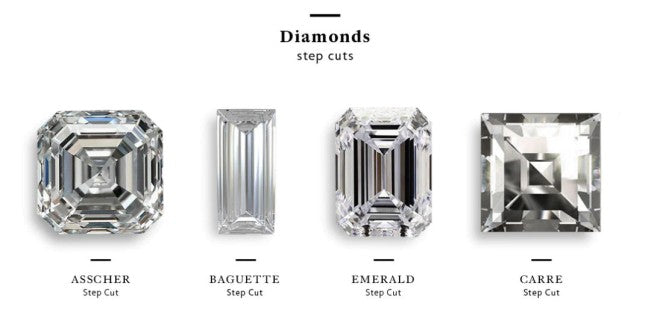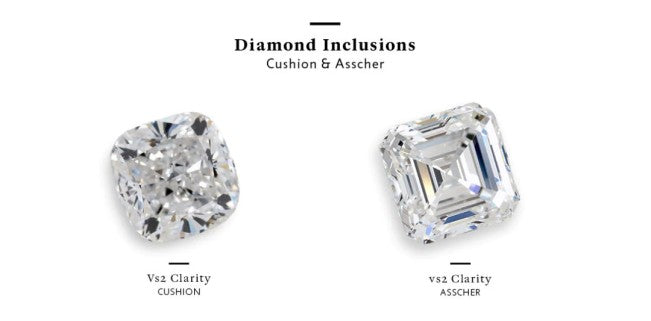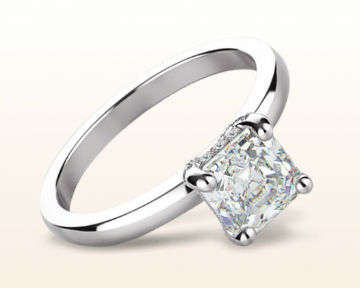So, How Are Step Cut Diamonds Different from Brilliant Cuts?
What do we think about when we think about diamonds?
When many of us consider a diamond — and some of us think about diamonds a lot, like it's our job or something — we often concentrate on its shape: Round, oval, the occasional pear. It stands to reason, as the shape is right there, so in-your-face (often literally, accompanied by joyful tears).
But an equally important characteristic to consider is a diamond's cut. The cut is directly related to the shape, and how a diamond will sparkle in its setting. Most of us are familiar with the basic cut of a round or oval diamond, which results in gorgeous faceting that glimmers like fire. Yet you may not be familiar with step cut diamonds, which are striking, stylish and quite trendy at the moment. Here are the basics, so you can decide if a step cut is right for you.
TABLE OF CONTENTS
What Shapes are Step Cut Diamonds?
The most popular step cut diamond styles are emerald, asscher, baguette and carré. All of them are cut with rectangular (or square) facets that graduate from the diamond's face like a set of steps. The emerald cut's long, rectangular facets create a flash known sometimes called a "hall of mirrors" effect. The asscher cut is a square-shaped style, with X-shaped facets running from its corners to its center culet that create mesmerizing sparkle. A baguette diamond is a rectangular step cut that may have straight or tapered edges. And the carré cut is a square shape whose facets may resemble a pyramid when viewed from above.

The Different Styles of Step-Cut Diamonds
The different styles of step-cut diamonds all have one thing in common: they tend to be longer and more rectangular in shape. In contrast, the shape of brilliant diamonds range anywhere from round to pear shaped to oval to square. But don't assume that all step-cut diamonds are the same, just because they’re made in a similar way. These elegant stones each have their own features that make them completely unique.
Emerald Diamonds
Emerald diamonds are the most popular of the step-cut diamonds, thanks to their regal look loved by royals and other celebrities (Kate Middleton rocks an emerald cut from Prince William… just saying). An emerald cut diamond is a rectangle with eight sides (the corners of the stone are clipped, creating the tiny edges). The long, rectangular facets on the stones create a “hours of mirrors” effect, meaning it looks like they go on and on (and on and on).
Asscher Diamonds
Named for the Asscher Brothers, Asscher diamonds tend to look like princess-cut diamonds from afar — thanks to their square-ish shape — but up close they have distinct step-cuts running from the corners to the center culet that create the sparkle.
Baguette Diamonds
While emerald and Asscher diamonds have softer corners, a baguette diamond has sharper, more pronounced edges that create a distinct rectangle shape. The step cuts used to create a baguette don't allow for a lot of sparkle, but they do reflect light in a distinct, hologram-like way. You’ll see these diamonds used as the side stones in three stone engagement rings a lot.
Carré Diamonds
Carré diamonds are the least popular out of all the step-cut diamond styles, but they're definitely interesting to look at. The facets on a carré cut — along with the square shape — make the stone look like a pyramid when viewed from above.
What's the Difference Between Brilliant Cut and Step Cut Diamonds?
The key difference between a step cut diamond and the brilliant cut is the amount of sparkle. Brilliant cuts, most commonly round cut diamonds or princess cut diamonds, have maximum sparkle. They possess more facets than step cuts, and the facets are triangular and kite-shaped, lending the diamond a fiery light performance. You can simply think of facets as faces that bounce light around your diamond.

Step cuts also have sparkle or fire, but a bit less than brilliant cuts. They're considered very elegant, but because they have fewer facets, they don't reflect as much light as brilliant cuts.
Benefits of Step Cut Diamonds
Step cut diamonds have a lot to recommend them — specifically, two celebrities. Ever since Kate Middleton and Lady Gaga flashed emerald-cut engagement rings, step cuts have experienced a surge in popularity. They have a sleek look that appeals to fans of vintage jewelry or minimalist-leaning fashion. Because step cuts preserve more of the rough diamond's carat weight, they cost less than brilliant cuts (in which more of the raw diamond is discarded) on average. And although step cuts may sparkle less, they provide a better showcase for a diamond's clarity.
Concerns of Step Cut Diamonds
In thinking about the four C's of a diamond — cut, clarity, color and carat — if a step cut diamond appeals to you, you may need to prioritize clarity over other characteristics, because any natural inclusions won't be as hidden as they would by the faceting of other cuts.

How the Cost Compares
Experts agree that the round brilliant diamond is the most expensive diamond cut, because of the precision cutting required to create a greater number of facets and the amount of raw diamond that is lost in the process. Because of their lower facet count, Emerald and Asscher cuts are among the most affordable diamond cuts, with baguette and carré styles in the middle of the mix.
But it's worth noting that baguettes and carré stones aren't those you would seek out for the center of your engagement ring. Both cuts are traditionally used as side stones in rings featuring multiple diamonds.
And remember, more facets don't make a more beautiful diamond — it's all about your personal style.
Shopping Guide: Our Favorite Step-Cut Diamond Rings
Not sure where to start shopping for step-cut diamond engagement rings? We've rounded up a few of our favorites — some traditional, some modern (but all jaw-droppingly beautiful).

Three Stone Baguette Diamond Engagement Ring
You get the best of both worlds with the Three-Stone Baguette Diamond Engagement Ring. The center stone is a striking princess cut, set off by two side baguettes. The result is a traditional-meets-modern look that combines the best elements of both styles of diamonds.

Three Stone Tapered Baguette Diamond Engagement Ring
A diamond engagement ring is a work of art, but the Three Stone Tapered Baguette Diamond Engagement Ring takes it to a whole other level. The high-profile ring is set off by .46 carats of accent stones and side baguettes, helping to draw the eye right into the sparkle of the center stone.

Classic Four Prong East West Diamond Engagement Ring
Round and princess-cut diamonds might be the norm for solitaire rings, but the Classic Four Prong East West Diamond Engagement Ring makes a strong case for changing the status quo. The east-west positioning of the center emerald makes it look larger than it really is (and people will definitely ask about your unique style).

Diamond Basket Solitaire Engagement Ring
At first glance, the center stone in the Diamond Basket Solitaire Engagement Ring looks like a princess cut, but look closer and you'll see that it's actually an Asscher diamond with multiple step cuts that add to its overall visual appeal. The simple four-prong setting means all the attention is on the important part: the diamond.

Princess Accent Diamond Engagement Ring
Looking for a thicker band? The Princess Accent Diamond Engagement Ring features a center Asscher cut stone flanked by large princess-cut accent diamonds on either side, along with a band full of smaller princess cut stones.

Two-Tone Bypass Diamond Engagement Ring
Where does the center stone end and the band begin? You won’t be able to tell with the Two-Tone Bypass Diamond Engagement Ring. The setting features a split shank that twists around the center stone — one split with princess-cut pave stones, one smooth — all leading to the emerald-cut diamond.
FAQs
Which are the most popular step-cut diamond shapes?
What are step-cut diamonds?
What is the ‘hall of mirrors’ effect in an emerald-cut diamond?
What is the difference between brilliant cut and step cut diamonds?
What are the benefits of step-cut diamonds?









